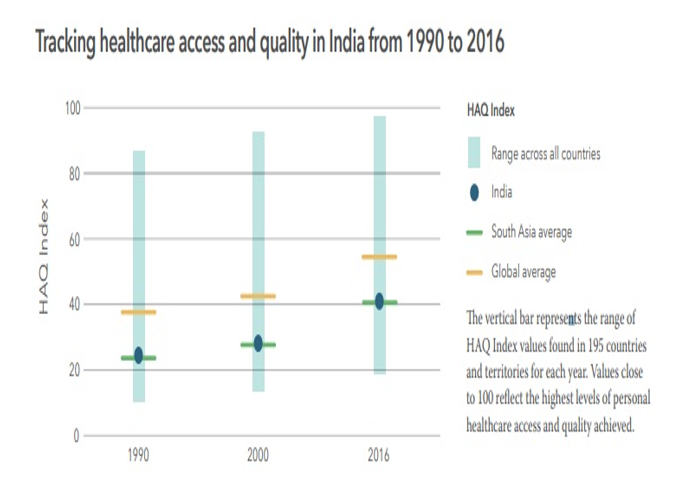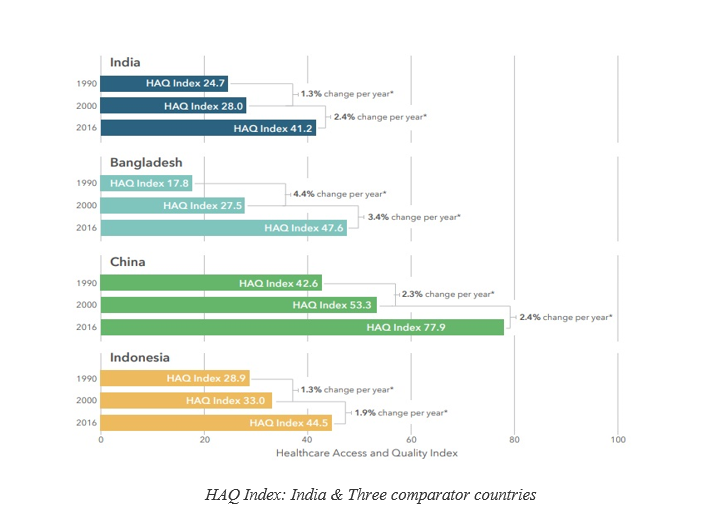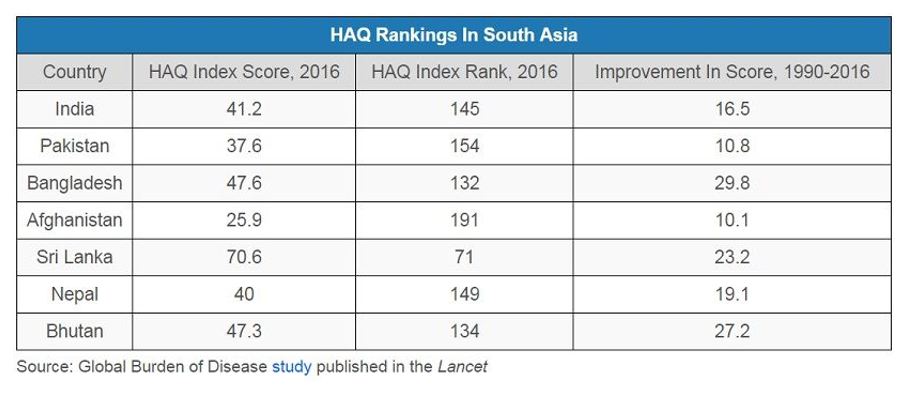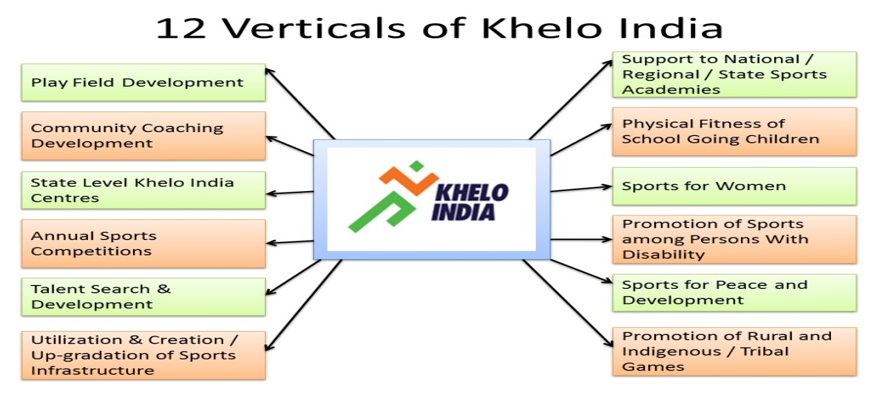Contemporary Concerns in Sports Management for New India
Download PDF
The healthcare Access and Quality (HAQ) Index reflects the expected length of life is good and enhancement of quality of life through the access to the maintenance of fitness in the body. India already it’s ranking on a global HAQ Index from 153 in 1990 to 145 in 2016, it is still below the global average.
‘Contemporary Concerns in Sports Management for New India’
Dr. Benu Gupta, Associate Professor and HOD, Department of Physical Education and Sports Sciences KMC University of Delhi
Abstract:
The healthcare Access and Quality (HAQ) Index reflects the expected length of life is good and enhancement of quality of life through the access to the maintenance of fitness in the body. India already it’s ranking on a global HAQ Index from 153 in 1990 to 145 in 2016, it is still below the global average.
The human capital in India is 20 years which is about 35% to 40% which should have been 60% at-least. Over 61% of all deaths in India are due to Non Communicable Diseases (NCDs) just because of unfit and unhealthy lifestyle. According to World Health Organization India has the highest number of diabetics are 50.8 million by 2025 if not take care of. The number one country on Fitness has 4.71 lac (100 thousand) annual income of individual where India stands.
Our GDP can be improves to 1.4% and human capital can be increased from 20 years to 64 years if we start and focus on Fit People Fit Nation. Plato, the legendary Greek philosopher advocated the need of a healthy mind in a healthy body to generate good leaders of the ideal republic. One of the main strategic objectives of the vision and mission of New India is to increase Human Capital. Bringing all stakeholders on board with true sports men spirit with strategic Sports Management in the country is the one major concern to achieve the vision of New India into reality.
Key Words: Contemporary Concerns, HAQ Index, Human Capital, GDP, Sports Management, New India
Today India is one of the youngest countries in the world with more than 62% of the population in the working age group (15-29 years) and more than 54% of the total population below 25 years of age. About 600 million young people and they are ready to change the world. No matter how poorly they find themselves now, they make up the world’s largest ever cohort of like-minded young people and they see absolutely no reason why the world shouldn’t run by their rules. The effect will be to change our world in ways one can’t imagine; India’s burgeoning youth are the world’s future.
Being into the era of New India and Young India, our major concern is that though our country has improved its ranking on a global healthcare access and quality (HAQ) index from 153 in 1990 to 145 in 2016, yet ranks lower than the global average. India ranked 115 positions in Human Capital Index (HCI) with its score of 0.44 on a scale of 0 to 1 even below the average score of South Asia.
The Healthcare Access and Quality (HAQ) Index reflects the expected length of life is good and enhancement of quality of life through the access to the maintenance of fitness in the body.
The Human Capital Index (HCI) database provides data at the country level for each of the components of the Human Capital Index as well as for the overall index, disaggregated by gender. The index measures the amount of human capital that a child born today can expect to attain by age 18, given the risks of poor health and poor education that prevail in the country where s/he lives.
In 2016, India scored 41.2 points on the healthcare access and quality (HAQ) index created by the Global Burden of Disease study published in the medical journal The Lancet on 23 May. This 16.5 point improvement in 26 years leaves India’s score well below the global average of 54.4. Despite improvement in healthcare access and quality, India lags behind its BRICS peers Brazil, Russia, China and South Africa on the HAQ index, but matches China in the disparity in healthcare access and quality between states.


Within India, the best performers, Goa and Kerala, scored more than 60 points on the HAQ index in 2016, whereas the worst performers, Assam and Uttar Pradesh, scored below 40. This gap between the highest and lowest scores increased from a 23.4 point difference in 1990 to a 30.8 point difference in 2016. (China fared the worst with a 43.5-point difference, ranging from 91.5 in Beijing to 48.0 in Tibet.)
The index is based on 32 causes of death considered preventable with effective medical care.
It assigns a 0-100 score to each of the 195 countries and territories assessed. For the first time, this year’s study analysed healthcare access and quality between regions within seven countries: Brazil, China, England, India, Japan, Mexico and the USA.

List of countries by Human Capital Index 2018 (India and its neighbouring countries)
|
HAQ Rank (2018) |
Country |
Score (% of potential reached) |
|
1 |
Singapore |
0.88 |
|
46 |
China |
0.67 |
|
55 |
Malaysia |
0.62 |
|
74 |
Sri Lanka |
0.58 |
|
87 |
Indonesia |
0.53 |
|
102 |
Nepal |
0.49 |
|
106 |
Bangladesh |
0.48 |
|
115 |
India |
0.44 |
|
133 |
Afghanistan |
0.39 |
|
134 |
Pakistan |
0.39 |
Reference: World Bank - World Development Report 2019, directed by Simeon Djankov and Federica Saliola
Top five countries with highest levels of Healthcare Access and Quality in 2016 are Iceland (rank 1st with score 97.1 points), Norway (2nd with 96.6), Netherland (3rd with 96.1), Luxembourg (4th with 96.0) and Finland and Australia (5th each with 95.9). The global average healthcare access and quality score in 2016 was 54.4, increasing from 42.4 points in 2000. The countries with lowest scores are Central Africa Republic (18.6) Somalia (19.0), Guinea-Bissau (23.4) , Chad (25.4) and Afghanistan (25.9). As far as India and its neighboring countries India lags behind China (48th) Sri lanka (71st) Bangladesh (133rd) and Bhutan (134th) in terms of HAQ Index level. But it is better than Nepal (149th) Pakistan (154th) and Afghanistan (191st) https://currentaffairs.gktoday.in/tags/haq-index-2020
The New India has taken cognizance of that the physical welfare of youth of the country should be one of the main concerns of the state and any departure from the normal standards of well-being at this period of life may have serious consequence. So as India has pinned to the key panacea programmes like Fit India Movement, Khelo India and International Yoga Day.
The Fit India Movement (FIT) is a nation-wide movement in India to encourage people to remain healthy and fit by including physical activities and sports in their daily lives. FIT contributes:
- Physical education is vital for the holistic development of young people improving their physical, social and emotional health.
- The benefits of physical education reach beyond the impact on physical wellbeing and the value of the educational benefits of sports should not be under-estimated within schools, physical education is an essential component of quality education.
- Not only do physical education program promote physical activity, participants in such program are also shown to have improved academic performance under certain conditions.
- Sports can also provide health alternatives to deviant behavior such as drug abuse, violence and crime.
- The educational impact of physical education includes both the development of motor skills and performance, as well as educational potential.
- This refers to the positive relationship between physical activities and educational development.
- Sports and physical education is fundamental to the early development of children and youth and the skills learned during play, physical education and sport contribute to the holistic development of young people.
Participation in sports develops following qualities with irrespective of the sex/gender:
- Good character
- Develops a sense of discipline.
- Develops loyalty.
- Social control/self-control
- Prepares the athletes for life.
- Provides opportunities for individual advancement
- Sports participation generates physical fitness
- Sports participation generates mental alertness
- Sports participation is supportive of education achievement
- Sports participation promotes nationalism
To achieve broader goals in education and development, sports program must focus on the development of the individual and not only on the development of technical sports skills while the physical benefits of participation in sports are very well known and supported by large volume of empirical evidence. Sports and physical activity can also have positive benefits on education.
Physical activity has benefits beyond improved grades, too:-
- Drop-out rates were lower for youth who consistently participated in interscholastic sports.
- They build the body and refresh their mind
- They train the mind in many virtues.
- They teach discipline and team spirit.
- Physical education creates in students the sporting spirit
- They develop pluck and patience
- Sports teach them to take a defeat in a good spirit
The Khelo India Scheme aims to encourage sports all over country, thus allowing the population to harness the power of sports through its cross cutting influence, namely holistic development of children & youth, social integration, gender equality, healthy lifestyle, National pride and economic opportunities.
Player development is all about players learning specific technical skills and beginning to understand tactical play. Talent identification is not based on merely what the player knows at the time of being evaluated but also his ability to learn, develop and progress in his ability to execute his skills. Important talent factors includes Genetics, Environmental, Physical activity, Practice, Nutrition, Psychological variables.

As per United Nation’s Sustainable Development Goals, the SDG-3 Good Health and Well Being promoted healthy living on other side the International Olympic Committee (IOC) also promoting active lifestyle through its Olympic Value Education Programme (OVEP 2.0). May it be the Olympic Values Respect Friendship Excellence, Olympic Educational Values Joy of Effort, Fair Play, Balance between Body Will and Mind or the Paralympic Values Determination Courage Inspiration and Equality; all promotes and encourage the Healthy Happy and Fit Human to contribute the Global Family ‘Vasudhaiv Kutumbakam’ To attain the required out put the major concern is to improving Sports Management Skills, Management of Environment, Management of Resources and Management of Activities in our country. We need to live Olympic Values, Fit People Fit Nation and make health and fitness a way of like as in Indian Ancient Culture in modern way by promoting or organising sports , fitness and recreational products. We need to replace I into WE and ILLNESS into WELLNESS.
Our GDP can be improved to 1.4% and human capital can be increase from 20 years 64 years if start and focus on FIT PEOPLE FIT NATION platform, the legendary Greek Philosopher advocated the need of healthy mind in a healthy body to generate good leaders of the ideal republic. One of the main strategic objectives of the vision and mission of NEW INDIA is to increase human capital. Bringing all stake holders on board with true sportsman spirit with strategic sports management in the country is the one major concern to achieve in the version of New Fit India into reality. In YOUNG INDIA NEW INDIA the Power to Change lies with the Youth “Ek Bharat, Shreshtha Bharat” we shall provide opportunities and atmosphere for them to explore and excel.
References:
https://www.sciencedirect.com/science/article/pii/S0140673617321542
https://www.eui.eu/events/detail?eventid=160686
http://www.healthdata.org/sites/default/files/files/county_profiles/HAQ/2018/India_HAQ

















